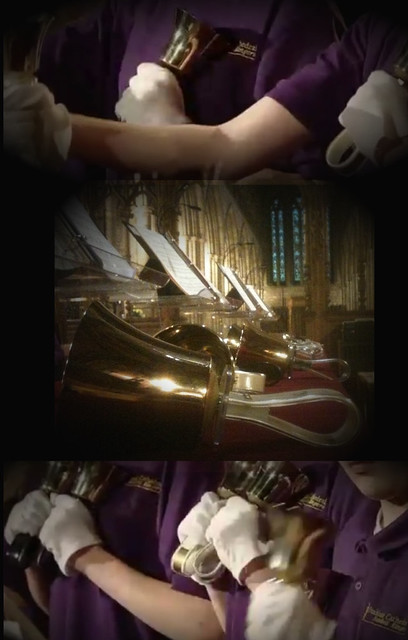Improvised Ringing
"Joyous Acclamations"
 Guide for one method of creating an improvised impromptu performance of music for handbells by a group of ringers or non-ringers, music readers or those who do not read music. This can be used at the start of a service of worship at any time of year and the title varied to suit the occasion. Confidence in the conductor is key and clear direction by the conductor in the preparation with ringers before the performance. What the conductor actually directs once the music begins will vary to suit the conductor, the nature of the service, time of year, and the spirit of the ringers taking part.
Guide for one method of creating an improvised impromptu performance of music for handbells by a group of ringers or non-ringers, music readers or those who do not read music. This can be used at the start of a service of worship at any time of year and the title varied to suit the occasion. Confidence in the conductor is key and clear direction by the conductor in the preparation with ringers before the performance. What the conductor actually directs once the music begins will vary to suit the conductor, the nature of the service, time of year, and the spirit of the ringers taking part.
Preparation
All handbells available to be distributed one to each person. Those who have never before played a handbell to be shown how to hold, ring and damp the handbell, and then to practise following the beat of the conductor to sound their handbell precisely together on each directed downstroke, and to all damp in cue by the conductor. Once all are able to sound their handbell on cue in unison with each other, and in direction of the conductor for varied rhythmic patterns entirely cued by conductor downbeats, then follow the steps below.
1. All ringers are grouped into 4 roughly equal-sized groups - equating to uppermost notes (soprano) in group 1, through upper-middle range (alto) for group 2, lower middle-range (tenor) for group 3, to lowest notes (bass) for group 4. It doesn't matter if the groups are not of equal size, nor does it matter if some notes from a different size-range are in another group.
2. Explain to ringers that when conductor's left hand shows one raised finger then ringers in group 1 prepare to ring. They are to ring exactly on the downbeat of the conductor's right hand. Likewise when the conductor's left hand shows two raised fingers then ringers in group 2 prepare to ring, following the rhythmic pattern beat out by the conductor's right hand. Likewise for 3 fingers for group 3, and four fingers for group 4.
3. Explain to ringers that until directed to damp (with the conductor damp signal) ringers should continue to let their handbells sound once another group begins to play.
4. The conductor cues each group in turn with the appropriate number of fingers in the left hand to indicate which group is to play, and providing varied rhythmic patterns with the right hand downbeats.
5. Two or three measures/bars of rhythmic patterns can be started by each group in turn before moving on to the next (always ringers continuing to let their bells sound on when the next group is cued to begin. Generally the uppermost bells will be cued to perform more complex and rapid rhythms while the lower most bells will have slower though still rhythmically interesting cued sections.
6. After generally going in sequence from top to bottom parts in turn for a total of about one minute of music, though still disrupting a straight predicable sequence, then disrupt the predicable further by two, three or four notes of quite rapid rhythms alternating between the top three groups for five or six seconds, breaking the rapid pattern with group 4 having slow rhythmic and perhaps syncopated patterns. Then repeat the upper parts fluctuating between groups one, two and three for two, three or four rapid notes each, before again having slower patterns from only group 4 (though of course all other notes continue to reverberate and do not damp). This pattern continues for about 30 seconds).
7. Conductor indicates with a sweeping left-arm motion that all groups now to play at the same time - in cued rhythms of conductor's right hand, starting with slower rhythms and quickly becoming more rapid as within about 15 seconds they build and build in volume until they all ring on cue the final note together - without damping and keeping the bells in motion until about 5 seconds elapse and finally the conductor cues everyone to damp their bells.
Malcolm C Wilson
